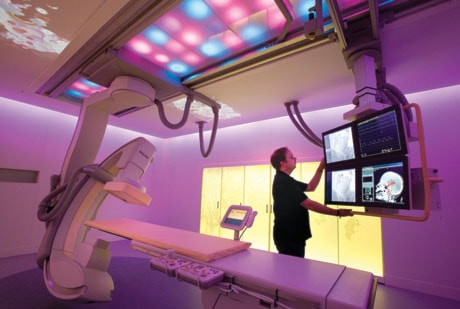If you’re having a heart attack, you may not need an emergency room at all, according to a groundbreaking study.
Researchers found that patients get faster care, and are more likely to survive, if an ambulance crew takes them straight to a specialized hospital “cath lab,” where doctors can act quickly to open their blocked arteries.
So far, only a small fraction of hospitals use this system, which relies on specially trained paramedics to diagnose heart attacks without the help of emergency room staff.
But the study, led St. Paul’s United Hospital heart specialist Dr. Kenneth Baran, suggests that it can cut the time needed to treat the most dangerous heart attacks from an average of 81 minutes to 36 minutes, and vastly improve the chances of recovery.
“Our times were phenomenal,” said Baran. In some cases, “we had patients in with their artery open in 20 minutes.”
In fact, the average for those who arrived during daytime hours was just 22 minutes — “the lowest that’s been recorded,” Baran said.
His research team also found that the patients who went straight to the catheter lab were less likely to die in the hospital (3.9 per cent) than those who came through the emergency room (7.5 per cent).
The study is in the July issue of Circulation: Cardiovascular Quality and Outcomes.
Experts say that the minutes after a heart attack are crucial because muscle starts to die when oxygen is cut off. If the blockage can be cleared within 60 minutes or so, experts say, the heart attack may cause little permanent damage.
That’s why hospitals and emergency medical systems across the country are scrambling to improve response times. “I think it’s quite inspirational,” said Dr. Henry Ting, who heads a similar program at the Mayo Clinic in Rochester. The study “shows what is possible with focus and creativity.”
Nationally, experts say, the “gold standard” for hospitals is to treat a heart attack patient within 90 minutes of arrival — called “door-to-balloon time” because doctors use an inflatable catheter to open the blockages.
Many hospitals have cut that time from 110 minutes to less than 80 in the past two years, said Ting, who serves on two national advisory panels. Mayo, United and other leading hospitals have cut that in half, in part by bypassing emergency rooms.
“Thirty to 40 minutes, that’s a major achievement,” he said.
Dr. Ganesh Raveendran, director of cardiac catheterization at the University of Minnesota, agrees. “This is the way it should be,” he said, noting that the university hospital has had similar results with an almost identical program. Most ambulances, he said, don’t have the proper equipment.
Baran said he began work on the process seven years ago, when heart attack patients coming from other hospitals would go straight to the catheter lab without stopping in the emergency room.
“Eventually, the idea emerged that maybe we could get medics to make the call in the field without having to double check with a doctor,” Baran said.
In 2007, he and other cardiologists began training 300 paramedics to read the results from ECG machines, which can reveal whether a specific type of heart attack has occurred. It became clear, he said, that paramedics could be just as accurate as doctors at correctly reading the results.
Baran says paramedics were quick to adopt the new program. Now patients are treated so quickly that some ambulance crews see their patients get better before their eyes.
When patients come in through the emergency room, by contrast, they may encounter delays in testing and evaluation, experts say.
Still, experts warn that some patients might need extra testing, to rule out pulmonary embolism or other conditions. “You have to be careful if it’s not straightforward,” said Dr. Alice Jacobs, a specialist with the Boston Medical Center and an adviser to the American Heart Association. “But if the diagnosis is clear . . . you save probably 15, 30 minutes if you bypass the ED.”
At first, some cardiologists who perform the catheter procedures were skeptical, Baran said, worried that they would face more false alarms, and have to act as both emergency room doctor and heart specialist. “It was a balancing act like herding cats,” he said. But when the results were so good, they said “this is worth it.”
If the idea becomes widely accepted, Baran said, the long-term implications are enormous. It could reduce the need for defibrillators and transplants, he said.
But Ting, of the Mayo Clinic, cautions that speeding up treatment is only part of the battle. Only half of those having heart attacks bother to call 911; they wait, on average, two hours before going to the hospital.
“This is one piece of the puzzle,” he said. “But we’ve got a lot of work ahead of us.”
